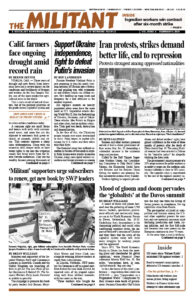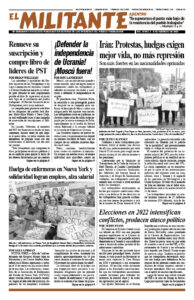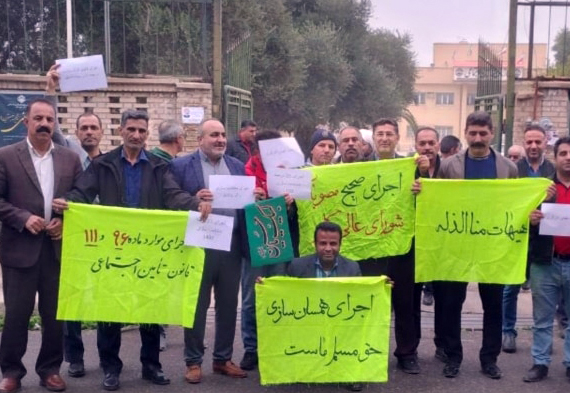Retirees and other workers protested outside at least a dozen government offices across Iran Jan. 22 demanding a substantial increase in the minimum wage and pensions.
Called by the Haft Tappeh Sugarcane Workers Union, the Coordinating Committee to Help Build Labor Unions, the Khuzestan Social Security Retirees and the Retirees Union Group, the workers are planning further nationwide actions every Sunday.
Workers fighting to improve job conditions and defend workers’ rights have gained confidence in the wake of three months of protests after the death of Zhina Amini Sept. 16. The young Kurdish woman had been arrested in Tehran by the “morality police” for allegedly violating the dress code.
The government’s announcement of a 20% wage increase for public workers is in reality a wage cut, the coalition said, because inflation is close to 50% annually. The capitalist crisis is exacerbated by the cost of the regime’s military interventions in Iraq, Lebanon, Syria and Yemen and the impact of U.S. and European Union sanctions. The value of Iran’s currency in relation to the U.S. dollar dropped to a record low Jan. 22.
Workers need a monthly minimum wage of 25 million tomans ($556), the statement said, “to defend their lives and the lives of their families and loved ones.”
Dozens of retired teachers in Tehran, mostly women, chanted “High prices, inflation, disaster for people’s lives.” Protests were held in Kurdistan, Yazd, Khuzestan, Gilan, Isfahan and other provinces.
Officials of the Islamic Republic claim to defend the interests of working people, but a leader of the protests said that the government’s Supreme Labor Council, which sets the minimum wage, acts in “the interests of the capitalist owners and nothing else.”
“Workers can exercise our power and be decision-makers for class interests only by creating independent labor organizations, independent from the government, the bosses and the political parties,” retiree Ali Nejati wrote on the sugarcane workers union website.
While the bourgeois-clerical regime has killed more than 500 protesters and arrested thousands since the protests began, it has been more cautious in its approach to struggles by workers over wages and conditions. Over the last several years a good number of leaders of the teachers and bus drivers unions have been imprisoned on trumped-up charges, but the police have not interfered in most of the latest labor actions or protests by farmers, a sign of the rulers’ fear of the power of the working class.
Weekly protests continue in Baluchistan — including one of thousands in Zahedan Jan. 20 — home to the mostly Sunni Muslim Baluch people and other oppressed minorities.
Close allies of Supreme Leader Ayatollah Ali Khamanei have denounced Zahedan-based Maulana Abdul-Hamid, the most prominent Sunni cleric in the country, for calling for freedom of worship, women’s equality, an end to the death penalty, equal rights for Baluchs, Arabs, Azerbaijanis, Kurds and other oppressed nationalities and release of political prisoners.
The government had admitted to “shortcomings” after 80 peaceful protesters were killed by the Islamic Revolutionary Guard Corps police and Basij thugs at a Sept. 30 protest in Zahedan. Nonetheless, at the end of December the government appointed Revolutionary Guard Corps Brig. Gen. Mohammad Karami the new governor of the province.
The Revolutionary Guard are widely hated for their brutal assaults at home and their role in the Iranian rulers’ wars abroad. Opposition to the bourgeois-clerical regime’s counterrevolutionary military adventures abroad, aimed at extending its reactionary presence across the Middle East, has been a feature of the wave of protests since late 2017.
Regime struggles to enforce dress code
After Amini’s death, the regime pulled the “morality police” off the streets in Tehran, hoping to avoid provoking more protests. Thousands of women there — and to a lesser extent in other cities — don’t cover their hair, while others continue to do so.
“A weak hijab is inappropriate,” stated Khamenei Jan. 3, “but it should not cause that individual to be seen as outside of religion and the revolution,” a recognition of the challenge the regime faces.
In mid-January it issued new rules that women who violate the code will face fines, confiscation of their vehicles and firing from their jobs instead of arrest. Businesses that let them enter would also face fines.
When three female high school students in Yazd boarded a bus recently, one passenger and her daughter told them to cover up and put on their hijab and threatened to report the students to school officials.
“It has nothing to do with you,” one student said, refusing to cover her hair. The older woman told the driver he shouldn’t let women ride the bus without proper hijab.
The bus driver replied, “It’s none of my business.”


